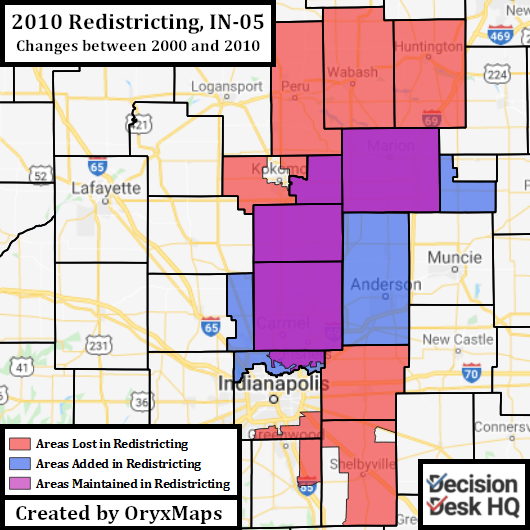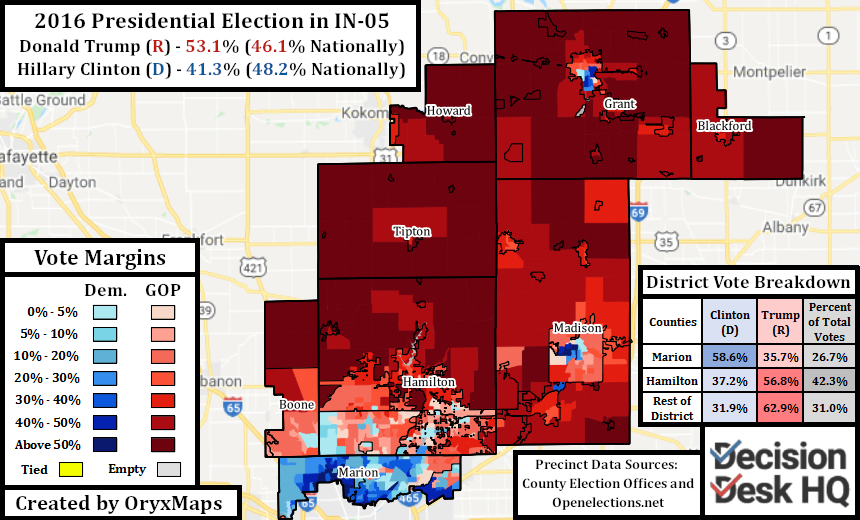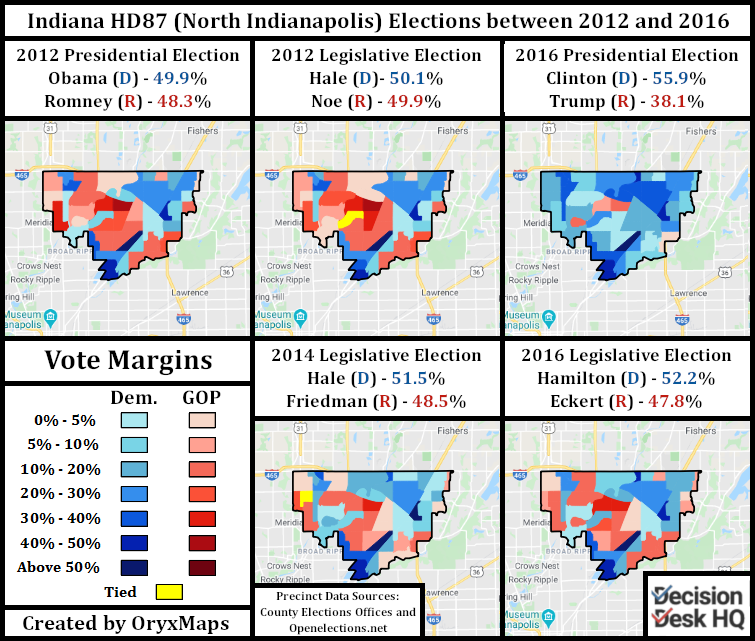No Democratic presidential candidate has won Hamilton County, the suburban county just north of Indianapolis, since 1916. Hamilton County has anchored congressional districts since the Voting Rights Act established “One Man, One-Vote,” and today has about 40% of IN-05’s residents. None of these modern congressional districts based out of Hamilton County have ever sent a Democrat to Washington. Despite a fierce Republican ancestry and a resident population that is 80% White, IN-05 is now a Democratic target. The DDHQ Forecast Model, Cook Political, and Sabato’s Crystal Ball all consider it a Toss Up race.

The Indiana Republican Party controlled 2010 redistricting. Indiana’s previous map elected a majority Democratic delegation in 2006 and 2008. Republicans sought to redraw the lines to lock their opposition into just two districts. IN-05, previously a suburban Republican pack, lost areas safe for the GOP and picked up areas considered swingy. The GOP put Madison County, parts of Boone and Blackford Counties, and more of Northern Indianapolis into IN-05, retaining only 55% of the previous district by 2010 population. Data at the time suggested Hamilton County and it’s environs had enough Republican voters to sink these added areas and still remain a safe GOP seat. Unfortunately for Republicans, their decision to add more of Indianapolis to the district has directly led to IN-05’s present status as a Toss Up.

Donald Trump won IN-05 in 2016 with 53.1% to Hillary Clinton’s 41.3%, a margin of 11.8%. This was Clinton’s best performance among Indiana’s seven Republican congressional districts. Indiana moved about 4.5% towards Republican candidates between 2012 and 2016, and Clinton lost ground in all but five of Indiana’s counties when compared to Obama’s performance in 2012. Three of the five counties though are Boone, Hamilton, and Marion, which combined cast 74% of the 2016 presidential vote in IN-05. Clinton picked up voters in suburbs like Carmel and Zionsville, swinging IN-05 towards the Democrats.

Democrat Joe Donnelly lost his Senate seat to Republican Mike Braun by a margin of about 6% in 2018, 50.7% to 44.8%. Despite his loss statewide, Donnelly carried IN-05 by 0.5%. Donnelly previously carried IN-05 when he won his Senate seat in 2012, but only by 1.2%. In 2012, IN-05 voted to the right of an already Republican-leaning state. In 2018, the district voted to the left of Indiana, a significant shift in just six years. Donnelly improved upon Clinton everywhere, earning more votes among rural, suburban, and urban communities. Despite this surge at the top of the ballot, incumbent Republican Susan Brooks won by 13.5% in a congressional race rated Safe Republican.
Brooks announced her decision to retire from Congress on June 14, 2019. Cook Political immediately moved the seat from Safe to Leans Republican, citing the district’s trend towards the Democrats. Brooks had never faced serious opposition after winning the eight-candidate Republican primary in 2012. In fact, the 13.5% margin 2018 was Brooks’ worst margin of victory during her eight years as a Representative. Democrats therefore were quick to argue that she decided to retire rather than face a potentially competitive race.

Democrats supported former Indiana State Representative Christina Hale, someone with experience winning competitive races, in the June 2nd primary. Hale left her position at Kiwanis International in 2012 to run for Indiana’s fluid State House District 87. She carried the district by the slimmest of margins, winning by 51 votes out of 32,509 cast. 2014 was a worse year for Democrats nationally when compared to 2012, yet Hale widened her margin of victory. 2016 Democratic gubernatorial candidate John Gregg selected Hale as his nominee for Lieutenant Governor, though their ticket lost statewide by 6%. Hale’s successor in HD87, Carey Hamilton, won another close race in 2016, even as Clinton won by 17.8% at the top of the ticket. HD87 is no longer considered competitive, as Hamilton surpassed Clinton’s 17.8% in 2018, but Hale had held onto the seat when it was still a battleground.
Hale is running as a moderate, trying to fit into the mold of the historically Republican IN-05. Hale has been endorsed by Barack Obama and Elizabeth Warren, yet her ads focus on how she worked with legislative Republicans to pass bills. According to July financial reports, Hale leads in money raised and cash on hand, having raised $1.47 million, and had $726K on hand in the middle of July.
Indiana Republicans nominated State Senator Victoria Spartz after a contentious primary. Spartz outspent and eventually crushed her competition, defeating her nearest opponent Beth Henderson (who ran ads against Spartz’s Ukrainian heritage) by 22%. Spartz is currently the State Senator for Senate District 20, a rectangular district in the middle of Hamilton County, but the 2020 primary was her first experience with electoral politics. Spartz was appointed to replace retiring Senator Luke Kenley in 2017, whose term was set to end in 2020. Despite Spartz’s thin elective resume, she is not a newcomer to Republican politics. She was a founding member of the Hamilton County Tea Party, served a term as President of the Hamilton County Republican Women, and later became vice-chairman of the Hamilton County Republican Party.
Spartz says she is the personification of the American dream. She argues her conservative values born from a reaction to her youth in Soviet Ukraine, and ingrained through her work in Hamilton County will appeal to this Republican-leaning district. Spartz lent her campaign $1 Million and raised an additional $290K by the middle of July, but the competitive GOP primary left her with only $170K cash on hand.
Three internal polls (2 Democratic: Tulchin Research and Global Strategy Group, 1 Republican) of the race were released this August, following an initial Democratic internal in late June. All four point towards a tight race between Hale and Spartz. The Democratic polls released Presidential numbers, and in all three Biden has 50% of the vote or more. If Biden flips IN-05, a district Trump won by 11.8%, there will be a significant number of individuals who voted Republican in 2016 but shift to Biden in 2020. These voters will decide the fate of this Toss Up congressional race.
Benjamin Lefkowitz (@OryxMaps) is a contributor to Decision Desk HQ